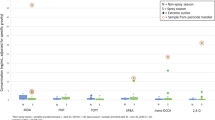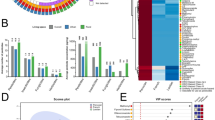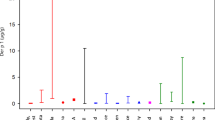Abstract
An environmental measurement and correlation study of nondietary ingestion of pesticides was carried out in a colonia in south Texas. The purpose of the study was to evaluate young children's exposure to environmental levels of organophosphate (OP) pesticides in the household. Samples were collected to measure levels of OP pesticides in housedust and on children's hands. These, in turn, were compared to levels of OP pesticide metabolites in urine. A total of 52 children, 25 boys and 27 girls, participated in the spring and summer of 2000. The children were 7–53 months of age at the time of recruitment. Univariate and multivariate regression analyses were carried out using SAS statistical software. Seventy-six percent of housedust samples and 50% of hand rinse samples contained OP pesticides. All urine samples had at least one metabolite and over 95% had at least two metabolites above the limit of detection (LOD). Total OP loadings in the housedust ranged from nondetectable (nd) to 78.03 nmol/100 cm2 (mean=0.15 nmol/100 cm2; median=0.07 nmol/100 cm2); total OP loadings on the children's hands ranged from nd to 13.40 nmol/100 cm2 (mean=1.21 nmol/100 cm2; median=1.41 nmol/100 cm2), and creatinine corrected urinary levels (nmol/mol creatinine) of total OP metabolites ranged from 3.2 to 257 nmol/mol creatinine (mean=42.6; median 27.4 nmol/mol creatinine). Urinary metabolites were inversely associated with the age of the child (in months) with the parameter estimate (pe)=−2.11, P=0.0070, and 95% confidence interval −3.60 to −0.61. The multivariate analysis observed a weak association between concentrations of OP pesticides in housedust, loadings in housedust, and concentration on hands, hand surface area, and urinary levels of OP metabolites. However, hand loadings of OP pesticides were more strongly associated (r2=0.28; P=0.0156) with urinary levels of OP metabolites (pe=6.39; 95% CI 0.98–11.80). This study's preliminary findings suggest that surface loadings of pesticides, on hands, are more highly correlated with urinary bioassays and, therefore, may be more useful for estimation of exposure in epidemiologic studies than levels of pesticides in housedust.
This is a preview of subscription content, access via your institution
Access options
Subscribe to this journal
Receive 6 print issues and online access
$259.00 per year
only $43.17 per issue
Buy this article
- Purchase on Springer Link
- Instant access to full article PDF
Prices may be subject to local taxes which are calculated during checkout

Similar content being viewed by others
References
Bradman M A, Hearnly M.E., Draper W., Seidel S., Teran S., Wakeham D., and Neutra R. Pesticide exposures to children from California's Central Valley: results of a pilot study. J Expos Anal Environ Epidemiol 1997: 7: 217–234.
Bravo R., Driskell W.J., Whitehead R.D. Jr, Needham L.L., and Barr D.B. Quantification of dialkyl phosphate metabolites of organophosphate pesticides in human urine using GC-MS/MS with isotopic internal standards. J Anal Toxicol, 2002: 26: 245–252
Centers for Disease Control and Prevention (CDC). National Report on Human Exposure to Environmental Chemicals [Online]. Available at http://www.cdc.gov/nceh/dlsreport (2001:
Davis J.R., Brownson R.C., and Garcia R. Family pesticide use in the home, garden, orchard, and yard. Arch Environ Contam Toxicol 1992: 22: 260–266.
Environmental Protection Agency (EPA). Method 3545: Pressurized Fluid Extraction (PFE). Test Methods for Evaluating Solid Waste, Physical/Chemical Methods, SW-846 [Version 2 (December 1997), Integrated Manual through Update III], Washington, DC, U.S. Environmental Protection Agency, 1997a.
Environmental Protection Agency (EPA). Method 8141A: Organophosphorus Compounds by Gas Chromatography: Capillary Column Technique. Test Methods for Evaluating Solid Waste, Physical/Chemical Methods, SW-846 [Version 2 (December 1997), Integrated Manual through Update III], Washington, DC, U.S. Environmental Protection Agency, 1997b.
Ezzel J. The Use of SW-846 Method 3545 for Automated Extraction of Environmental Samples, American Environmental Laboratory, International Scientific Communication (ISC), Shelton, CT, January 1998, pp. 24–26.
Fenske R.A., Black K.G., Elkner K.P., Lee C.L., Methner M.M., and Soto R. Potential exposure and health risks of infants following indoor residential pesticide application. Am J Public Health 1990: 80: 689–693.
Fenske R.A., Kissel J.C., Lu C., Kalman D.A., Simcox N.J., Allen E.H., and Keifer M.C. Biologically based pesticide dose estimates for children in an agricultural community. Environ Health Perspect 2000: 108: 515–520.
Griffith J.G., and Duncan R.C. Dialkyl phosphate residue values in the urine of Florida citrus fieldworkers compared to the National Health and Nutrition Examination Survey (NHANES) sample. Bull Environ Contam Toxicol 1985: 34: 210–215.
Hill R.H., Head S.L., Baker S., Shealy D.B., Bailey S.L., Williams C.G., Sampson E.J., and Needham L.L. Pesticide residues in urine of adults living in the US. Environ Res 1995: 71: 99–108.
Hu Y.A., Barr D.B., Akland G., Melnyk L., Needham L., Pellizzari E.D., Raymer J.H., and Roberds J.M. Collecting urine samples from young children using cotton gauze for pesticide studies. J Expos Anal Environ Epidemiol 2000: 10: 703–709.
Loewenherz C., Fenske R.A., Simcox N.J., Bellamy G., and Kalman D. Biological monitoring of organo-phosphorous pesticide exposure among children of agricultural workers in Central Washington State. Environ Health Perspect 1997: 105: 1344–1353.
Lu C., and Fenske R.A. Dermal transfer of chlorpyrifos residues from residential surfaces: comparison of hand press, hand drag, wipe, and polyurethane foam roller measurements after broadcast and aerosol pesticide applications. Environ Health Perspect 1999: 107: 463–467.
Lu C., Fenske R.A., Simcox N.J., and Kalman D. Pesticide exposure of children in an agricultural community: evidence of household proximity to farmland and take home exposure pathways. Environ Res 2000: 84: 290–302.
McCauley L.A., Lasrev M.R., Higgins G., Rothlein J., Muniz J., Ebbert C., and Phillips J. Work characteristics and pesticide exposures among migrant agricultural families: a community-based research approach. Environ Health Perspect 2001: 109: 533–538.
McCurdy S.A., Hansen M.E., Weisskopf C.P., Lopez R.L., Schneider F., Sanborn J.R., Krieger R.I., Wilson R.W., and Goldsmith D.F. Assessment of azinphosmethyl exposure in California peach harvest workers. Arch Environ Health 1994: 49: 289–296.
O'Rourke M.K., Lizardi P.S., Rogan S.P., Freeman N.C., Aguirre A., and Saint C.G. Pesticide exposure and creatinine variation among young children. J Expos Anal Environ Epidemiol 2000: 10: 673–681.
Patnaik P. Handbook of Environmental Analysis: Chemical Pollutants in Air, Water, Soil, and Solid Wastes. Lewis/CRC Press, Boca Raton, FL, 1997, pp. 215–220.
Richter E.D., Kowalski M., Leventhal A., Graver F., Marzouk J., Brenner S., Shkolnik I., Lerman S., Zahavi H., and Bashavi A. Illness and excretion of organophosphate metabolites four months after household pest extermination. Arch Environ Health 1992: 47: 135–138.
Richter B., Ezzel J., and Felix D. Single Laboratory Method Validation Report: Extraction of Organophosphorus Pesticides, Chlorinated Herbicides, and Polychlorinated Biphenyls Using Accelerated Solvent Extraction (ASE) with Analytical Validation by GC/NPD and GC/ECD, Document 101124. Dionex, Sunnyvale, CA, 1994.
Richter B., Hoefler F., and Linkerhaeger M. Determining Organophosphorus Pesticides in Foods Using Accelerated Solvent Extraction with Large Sample Sizes, Volume 19. LCGC, Eugene, OR April 2001: pp. 408–412, (No. 4).
Savage E.P., Keefe T.J., Wheeler H.W., Mounce L., Halwic L., Applehans F., Goes E., Goes T., Mihlan G., Rench J., and Taylor D.K. Household pesticide usage in the United States. Arch Environ Health 1981: 36: 304–309.
Schantz M., Nichols J.J., and Wise S.A. Evaluation of pressurized fluid extraction for the extraction of environmental matrix reference material. Anal Chem 1997: 69: 4210–4219.
Shalat S.L., Robson M.G., and Mohr S.N. Agricultural workers. In: Rosenstock L., Cullen M.R., Brodkin C.D., and Redlich C. (Eds), Textbook of Clinical Occupational and Environmental Medicine, 2nd edn. Saunders, Philadelphia, PA, 2003 (In press)
Simcox N.J., Fenske R.A., Wolz S.A., Lee I.C., and Kalman D.A. Pesticides in household dust and soil: exposure pathways for children of agricultural families. Environ Health Perspect 1995: 103: 1126–1134.
Sumner D., and Langley R. Pediatric pesticide poisoning in the Carolinas: an evaluation of the trends and proposal to reduce the incidence. Vet Hum Toxicol 2000: 42: 101–103.
van Wijnen J.H., Clausing P., and Brunekreef B. Estimated soil ingestion by children. Environ Res 1990: 51: 147–162.
Wade T.L., Brooks J.M., Kennicutt M.C. II, McDonald T.J., Sericano J.L., and Jackson T.J. GERG trace Organics contaminant analytical techniques. In: Lauenstein G.G., and Cantillo A.Y. (Eds), Sampling and Analytical Methods of the NOAA National Status and Trends Program National Benthic Surveillance and Mussel Watch Projects 1984–1992: Vols. I –IV. Technical Memorandum. NOS ORCA 71, 1993. NOAA/NOS/ORCA, Silver Spring, MD, 1986, pp. 121–128.
Whitemore R.W., Immerman F.W., Camann D.E., Bond A.E., Lewis R.G., and Schaum J.L. Non-occupational exposures to pesticides for residents of two US cities. Arch Environ Contam Toxicol 1994: 26: 47–59.
Zuloaga O., Etxebarria N., Fernandez L.A., and Madariaga J.M. Optimization and comparison of MAE, ASE and Soxhlet extraction for the determination of HCH isomers in soil samples. Fresenius’ J Anal Chem 2000: 367: 733–737.
Acknowledgements
This project was supported by EPA STAR grant no. R827440 and NIEHS grants to the Center for Environmental Health Sciences in Piscataway, NJ (P30-ES-05022), and the Center for Environmental and Rural Health at Texas A&M University (P30-ES-09106). This study would not have been possible without the cooperation and assistance of the Sisters of Mercy of Laredo, TX.
Author information
Authors and Affiliations
Corresponding author
Rights and permissions
About this article
Cite this article
Shalat, S., Donnelly, K., Freeman, N. et al. Nondietary ingestion of pesticides by children in an agricultural community on the US/Mexico border: Preliminary results. J Expo Sci Environ Epidemiol 13, 42–50 (2003). https://doi.org/10.1038/sj.jea.7500249
Received:
Published:
Issue Date:
DOI: https://doi.org/10.1038/sj.jea.7500249
Keywords
This article is cited by
-
Occurrence, analysis and removal of pesticides, hormones, pharmaceuticals, and other contaminants in soil and water streams for the past two decades: a review
Research on Chemical Intermediates (2022)
-
Sampling scheme for pyrethroids on multiple surfaces on commercial aircrafts
Journal of Exposure Science & Environmental Epidemiology (2010)
-
Determination of no-observed effect level (NOEL)-biomarker equivalents to interpret biomonitoring data for organophosphorus pesticides in children
Environmental Health (2009)
-
Urine-sampling methods for environmental chemicals in infants and young children
Journal of Exposure Science & Environmental Epidemiology (2009)
-
Multimedia measurements and activity patterns in an observational pilot study of nine young children
Journal of Exposure Science & Environmental Epidemiology (2008)



